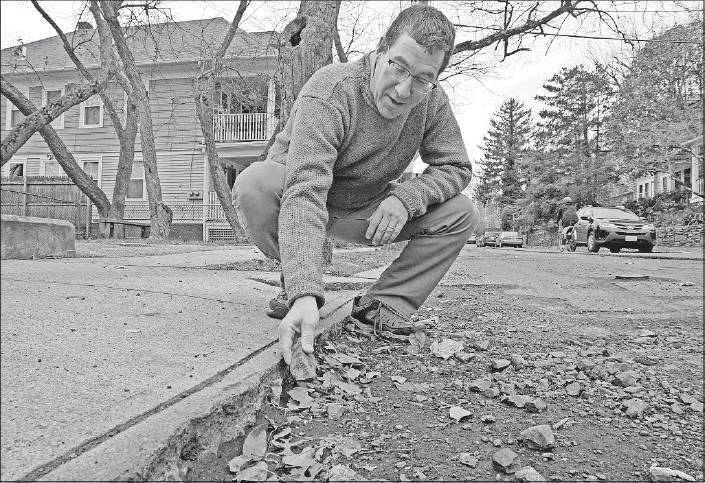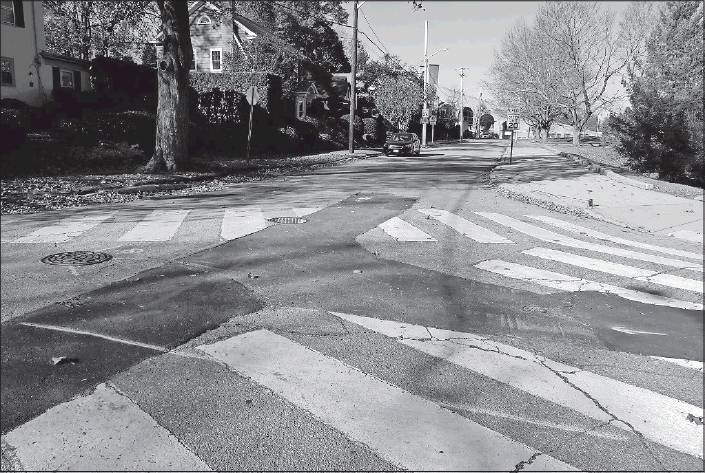THE HUMMEL REPORT
Growing ire on the East Side over ‘unprecendented’ road work
By Jim Hummel The Hummel Report
PROVIDENCE
A multimillion-dollar project to replace aging natural gas and water pipes that began last spring has left many on the East Side navigating ripped-up roads, dodging uneven patches and wondering when work on their streets will begin and end.
“I’m shocked at the lack of coordination between the water, the gas and the city,” said Ruth Breindel, who has lived on Hope Street for 40 years. “The houses are filthy and nobody ever tells you anything.”
Breindel said a striping crew directly outside her bedroom window woke her up at 2 a.m., with no advance notice.
“There’s no accountability is what it comes down to,” said Mark Binder, who has lived on Morris Avenue for more than two decades. Binder said half of his road was dug up by National Grid to replace a gas line and repaved earlier this year. Then Providence Water dug up the other half in late October, but left it exposed with, raised manhole covers, for nearly a month.
“It’s an unprecedented amount of work being done in the city,” said Leo Perrotta, acting director of the Providence Department of Public Works. “We’ve seen millions of dollars being spent, for the first time in a long time. With that, there are some growing pains.”
Perrotta said there is a race for the utility companies to get roads paved or patched before winter arrives, and frequent rain this fall has been a challenge. “They’re all on notice: the winter season is coming,” Perrotta said. “They need to address all of their open areas, whether it’s milled or a patching area.”
Morris Avenue was finally paved on Saturday, Nov. 23 — the day the Brown University football team played Dartmouth at Brown Stadium, and Temple Emanu-El held Shabbat services, both just blocks away from the roadwork. It prompted Binder to tweet: #poorplanning #fail.
And, Binder said, contractors doing paving for Providence Water were in such a hurry to get the road done that they paved over several storm drains, blocking the heavy rains that came the next day. Binder posted video showing a small river running down his side of the street, with water splashing up over the curb.
Perrotta said the city’s Engineering Department spoke with Providence Water and the drains were fixed on Monday.
National Grid is spending $4.2 million to replace 16,000 feet of leak-prone distribution mains on the East Side. The work will continue into next spring after a winter break.
Providence Water launched a $7.2-million project to rehabilitate or replace 41,000 feet of water mains, including some of the oldest pipes in the distribution system. Contractors have been doing most of the work on East Side streets this fall. Providence Water provided The Hummel Report with a five-page list of streets and the status of the work of five different contractors the utility has hired, as of Nov. 19.
Some, like the streets in and around the heart of Brown University, were completed in September with fresh pavement. But others, on either side of Hope Street, are still in various states of restoration, with final work not scheduled until next spring.
The official tally: 19 streets have been completely restored, 41 are “in progress” for permanent street restoration before the end of the year, and 45 will have to wait until 2020 for complete restoration.
Crews paved many of the worst streets in the days leading up to Thanksgiving, but the quality of restoration on some of the patches has been a source of friction between the city and Providence Water.
The Hummel Report asked to interview any of the engineers or administrators with Providence Water who could answer questions about the work on the East Side. The utility declined, instead providing written answers through Christopher D. Hunter, a managing partner with Advocacy Solutions, a Providence communications and lobbying firm. Providence Water pays the company $4,000 a month for work that includes handling media inquiries.
The Hummel Report sent video to Providence Water, via Hunter, of three patches within a few blocks of Brown Stadium. Two had settled, causing passing cars to hit a shallow hole as they passed; another had uneven patching near a hydrant and a square section of pavement a few feet away with a two- to three-inch ledge where a previous patch had also settled.
The day after we sent the video, a crew hired by Providence Water filled several of the patches on Sessions Street, although not flush with the road. Instead, they caused a raised bump for motorists to navigate.
In all three cases, Hunter said the patches would be addressed before the end of the year. They had sat for months before our inquiry.
A 24-page agreement, signed in 2008 by the city and utilities, created a Utilities Coordinating Committee. Perrotta said the committee met in November 2018, and again last March. “The committee met to go over what projects are being done by the city or the utilities, and how they can work together — and stay out of each other’s way,” Perrotta said.
Contractors for Providence Water and National Grid have their own inspectors on-site to monitor their work. But the city is ultimately responsible for issuing permits and making sure the job is satisfactory.
Perrotta said city inspectors make periodic inspections and there is an ongoing dialogue with the utilities to address any concerns. The utilities said they communicate with each other as well.
Breindel questioned that, detailing the work near her house: “Last year the water and gas lines were redone, but the water on Whiting [a side street] wasn’t finished until mid-November. The gas company came and ripped up the south side of Whiting, then repaved this summer. The gas company then came and put [crosswalk] stripes across Whiting. Then the water company came and chopped up the other side of Whiting late summer/early fall and it’s still chopped up.”
Add to that paving that the city is doing with the help of a $20-million bond. A contractor hired by Providence recently repaved Hope Street from Rochambeau to Thayer Street.
Perrotta reacted to the video of the patch on Sessions Street that we had sent Providence Water, saying: “That’s unacceptable, that’s a void.”
Looking at another on Savoy Street: “It looks like you’ve got a little bit of a crack on the end where they milled it; it probably isn’t a straight milling line and it probably should have been,” Perrotta said. “And you’ve got some settling on the side. That’s one we definitely would have to look at.”
The city didn’t have to: within days of getting the video we sent, contractors for Providence Water had fixed all three problem areas that we had pointed out to Perrotta, which will get motorists through the winter until a permanent restoration can be made next spring.
Perrotta said there is sometimes disagreement, but the city gets the final say. “They like to defend their work, and when the criticism is due, we give it to them,” he said, adding that the DPW has asked for corrective action in some places and would do so for the areas we showed him.
Last month, in the basement of the Rochambeau Library, Ward 3 Councilwoman Nirva LaFortune held a community meeting to talk about several issues affecting the neighborhood — including the paving. Perrotta and Nate Urso from the city’s Traffic Engineering Division attended the meeting and got an earful from Breindel and Binder, who were sitting in the front row. And from Councilwoman LaFortune.
“It doesn’t sound like National Grid and [Providence Water] are always communicating,” she said. “And it also doesn’t sound like, based on my past communications, that they’re doing the repairs they should do. It is a major issue.”
Binder suggested the city use its PVD 311 system, created with much fanfare in 2016, to keep residents updated. It includes a 3-1-1 telephone line, a website and a mobile app, which has been downloaded more than 10,000 times. Perrotta said it’s something the city will explore.
“We really need to come up with a better process,” LaFortune said. “The [utilities] are not good at communication. There’s been a lot of times where the work has started in the middle of the night and people are startled by the noise.”
Urso responded: “There’s a process in place where they’re supposed to communicate. Each one of those paving projects has a project manager, and it’s his responsibility to make sure that notifications are given out to abutters, businesses and so forth.”
LaFortune countered: “It’s not happening.”
Binder said that the day after the meeting, “no parking” signs were posted on telephone poles across the street from his house on Morris Avenue, with a timetable of Nov. 20 to Nov. 27. He asked that the time frame be narrowed as some residents kept their cars off the streets in the first couple of days, then began parking there again when crews hadn’t shown up, resulting in tickets or towing.
LaFortune echoed that, asking Perrotta: “So can we have a timeline? I’m just really concerned that National Grid and the Water Department are getting away with not holding up their end. When those roads are not repaired, not only does it become a safety hazard, but then you think about claims that have to go in because of people’s cars destroyed by potholes because the roads are not properly paved.”
Binder also wants to know why the gas and the water companies don’t work on the same roads at the same time, so the construction window would be narrowed.
“It’s very difficult for the two of them to work in the same area, the same trenches,” Perrotta said. “It’s the logistics of being able to work on the lines. So you can’t have someone working on the water line, then the gas line. They may be very close to each other. But to dig it out and have two companies there at the same time, it’s not going to work. It’s not safe.”
The contractors have been hampered by the weather: they can’t pave when the roads are wet, and if it gets below 40 degrees, they have to use a warm mix additive to help the asphalt bind to the surface. In addition, many asphalt plants in the state are getting ready to close for the season.
“We’ve been fortunate that we haven’t had any really cold snaps at this point, the ground is still warm, the pavement is still warm,” Perrotta said, adding that he has a message for the people living on the East Side:
“We understand it’s not easy, it can be trying at times, it can be an aggravation, because of the unswept road or the dust. But the end product is: brand-new utilities, water, gas, a brand-new road. It’s great for the neighborhood, it’s great for the city, we just ask for patience. The end is coming soon.”
Until it starts up again in the spring.
The Hummel Report is a 501(c)
(3) nonprofit organization that relies, in part, on donations. For more information, go to HummelReport.org. Reach Jim at Jim@HummelReport.org.





